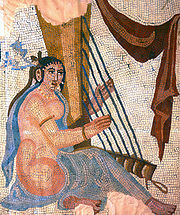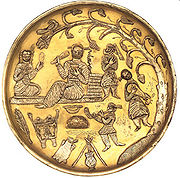
Sassanid music
Encyclopedia


Persian classical music dates to the sixth century BC; during the time of the Achaemenid Empire
Achaemenid Empire
The Achaemenid Empire , sometimes known as First Persian Empire and/or Persian Empire, was founded in the 6th century BCE by Cyrus the Great who overthrew the Median confederation...
(550-331 B.C.), music played an important role in prayer and in royal and national events. But Persian music had its zenith during the Sassanid dynasty from 224
224
Year 224 was a leap year starting on Thursday of the Julian calendar. At the time, it was known as the Year of the Consulship of Iulianus and Crispinus...
until 651
651
Year 651 was a common year starting on Saturday of the Julian calendar. The denomination 651 for this year has been used since the early medieval period, when the Anno Domini calendar era became the prevalent method in Europe for naming years.- Europe :* Clovis II, king of Neustria and Burgundy,...
AD.
In this era, many of Persian music's dastgah
Dastgah
Dastgāh is a musical modal system in traditional Persian art music. Persian art music consists of twelve principal musical modal systems or dastgāhs; in spite of 50 or more extant dastgāhs, theorists generally refer to a set of twelve principal ones...
s and modes were invented, most of them by Barbod. He employed 30 sounds for music. Naturally he recorded his inspirations and performed them for his audience, since if he did not, he could not play them again.
Dance and chanson were prevalent in court banquets. It said that on several occasions Persian musicians and dancers were gifted to the court of Chinese emperors by Sassanid kings, implying the high reputation and virtuosity of Persian musicians and dancers in that era. Another important role that music played was in the reception of foreign diplomats and kings from neighbouring countries, such as Byzantine
Byzantine Empire
The Byzantine Empire was the Eastern Roman Empire during the periods of Late Antiquity and the Middle Ages, centred on the capital of Constantinople. Known simply as the Roman Empire or Romania to its inhabitants and neighbours, the Empire was the direct continuation of the Ancient Roman State...
or Hephthalite
Hephthalite
The Hephthalites or Hephthalite is a pre-Islamic Greek term for local Abdali Afghans, who's famous ruler was Nazak Abdali . Hephthalites were a Central Asian nomadic confederation of the AD 5th-6th centuries whose precise origins and composition remain obscure...
s.
Five centuries after Barbod's death, Farabi made a record of all the musical pieces of his period and described the ancient note recording method. About 2,000 musical works and melodies and relics of that period have been passed on to us, including pieces from Barbod, Armove and Maraghi so that this music can be performed and played at present.
Music in Sassanid Iran
The history of musical performance in Sassanid Iran is however better documented than earlier periods. This is specially more evident in the context of Zoroastrian ritual. By the time of Xusro ParvizKhosrau II
250px|thumb|Khosrau II 250px|thumb|Khosrau II 250px|thumb|Khosrau II (Khosrow II, Chosroes II, or Xosrov II in classical sources, sometimes called Parvez, "the Ever Victorious" – (in Persian: خسرو پرویز), was the twenty-second Sassanid King of Persia, reigning from 590 to 628...
, the Sassanid royal court was the host of prominent musicians. In general the period of Xosro Parviz
Khosrau II
250px|thumb|Khosrau II 250px|thumb|Khosrau II 250px|thumb|Khosrau II (Khosrow II, Chosroes II, or Xosrov II in classical sources, sometimes called Parvez, "the Ever Victorious" – (in Persian: خسرو پرویز), was the twenty-second Sassanid King of Persia, reigning from 590 to 628...
reign is regarded as an "golden age of Iranian music" and himself is shown in a large relief at Taq-e Bostan
Taq-e Bostan
Taqwasân or Taq-e Bostan or Taq-i-Bustan is a series of large rock relief from the era of Sassanid Empire of Persia, the Iranian dynasty which ruled western Asia from 226 to 650 AD. This example of Sassanid art is located 5 km from the city center of Kermanshah in western Iran...
among his musicians and himself holding bow and arrows and while standing in a boat amidst a group of harpists. The relief depicts two boats and the whole picture shows these boats at "two successive moments within the same panel".
Instruments

Horn (instrument)
The horn is a brass instrument consisting of about of tubing wrapped into a coil with a flared bell. A musician who plays the horn is called a horn player ....
, the Daf
Daf
A daf is a frame drum used as a musical instrument in popular and classical music. The term daf is used in Iran / Kurdistan for a large drum that has a series of four interlinked rings in the frame. Daf is mostly used in Middle East, Iran, Armenia, Pakistan, Turkey, Tajikistan, Azerbaijan and ...
, the drum
Drum
The drum is a member of the percussion group of musical instruments, which is technically classified as the membranophones. Drums consist of at least one membrane, called a drumhead or drum skin, that is stretched over a shell and struck, either directly with the player's hands, or with a...
and the flute
Flute
The flute is a musical instrument of the woodwind family. Unlike woodwind instruments with reeds, a flute is an aerophone or reedless wind instrument that produces its sound from the flow of air across an opening...
or pipe. The harp
Harp
The harp is a multi-stringed instrument which has the plane of its strings positioned perpendicularly to the soundboard. Organologically, it is in the general category of chordophones and has its own sub category . All harps have a neck, resonator and strings...
is triangular, and has seven strings; it is held in the lap, and played apparently by both hands. The drum is of small size. The horns and pipes are too crudely represented for their exact character to be apparent. Concerted pieces seem to have been sometimes played by harpers only, of whom as many as ten or twelve joined in the execution. Mixed bands were more numerous. In one instance the number of performers amounts to twenty−six, of whom seven play the harp, an equal number the flute or pipe, three
the horn, one the drum, while eight are too slightly rendered for their instruments to be recognized. A portion of the musicians occupy an elevated orchestra, to which there is access by a flight of steps.
Famous Sassanid musicians

Khosrau II
250px|thumb|Khosrau II 250px|thumb|Khosrau II 250px|thumb|Khosrau II (Khosrow II, Chosroes II, or Xosrov II in classical sources, sometimes called Parvez, "the Ever Victorious" – (in Persian: خسرو پرویز), was the twenty-second Sassanid King of Persia, reigning from 590 to 628...
, the Sassanid royal court was the host of prominent musicians such as
Ramtin: He was also a remarkable musician.
Bamshad
Bamshad
Bamshad was one of the four most famous and skilled musicians lived in the Persian Sassanid dynasty when Xusro Parviz was in power . He used to play music with passion and full of energy in the beginning of everyday in the time of dawn, for this reason, people were always happy and pleased. That's...
: He was another court musician of Khosrau II
Khosrau II
250px|thumb|Khosrau II 250px|thumb|Khosrau II 250px|thumb|Khosrau II (Khosrow II, Chosroes II, or Xosrov II in classical sources, sometimes called Parvez, "the Ever Victorious" – (in Persian: خسرو پرویز), was the twenty-second Sassanid King of Persia, reigning from 590 to 628...
. He used to play early morning (dawn) songs which could please the king and people and bring happiness to the society.
Nakisa
Nakisa
Nakisa is the Arabicized pronunciation of the word Nagisa. Both names originate from the Persian word Negin. Many Persian words have Arabic pronunciations and some have changed over time completely to the Arabic form. The Arabic alphabet is similar to that of the Persian alphabet, yet lacks certain...
: She was also the court musician of the Sassanid Empire. The main theme of her songs were in praise of King Khosrau II
Khosrau II
250px|thumb|Khosrau II 250px|thumb|Khosrau II 250px|thumb|Khosrau II (Khosrow II, Chosroes II, or Xosrov II in classical sources, sometimes called Parvez, "the Ever Victorious" – (in Persian: خسرو پرویز), was the twenty-second Sassanid King of Persia, reigning from 590 to 628...
. The main instrument that she played was a harp. (written by Zahra Neshat-Taherzadeh)
Azad :
Sarkash
Sarkad
Sarkad may refer to:* Sarkad, Hungary, a town in Hungary* Sarkad·keresztúr* Sarkad·tanya, a village in Hungary...
: Though not as renowned as Barbod or Nakisa, he was a remarkable musician.
Barbad
Barbad
Barbad or Barbad the Jahromi was a Persian musician of the Sassanid era, who lived during the rule of Khosrau II, 590 to 628..- Etymology :...
: Barbad is remembered in much documents and has been named as remarkably high skilled. He has been credited to have given an organisation of musical system consisting of seven "Royal modes" named Xosrovani, thirty derivative modes named lahn, and 360 melodies named dastan. These numbers are in accordance with Sassanid's calendar
Iranian calendar
The Iranian calendars or sometimes called Persian calendars are a succession of calendars invented or used for over two millennia in Greater Iran...
of number of days in a week, month, and year. The theories based on which these modal system was based are not known, however the writers of later period have left a list of these modes and melodies. These names include some of epic forms such as kin-e Iraj (lit. the Vengeance of Iraj), kin-e siavash (lit. the Vengeance of Siavash), and Taxt-e Ardashir (lit. the Throne of Ardashir) and some connected with the glories of Sassanid royal court such as Bagh-e shirin (lit the garden of Shirin), Bagh-e Shahryar (lit. the Sovereign's Garden), and haft Ganj (lit. the seven threasures). There are also some of a descriptive nature like roshan cheragh (lit. bright lights).
See also
- Sassanid art
- Music of IranMusic of IranThe music of Iran has thousands of years of history, as seen in the archeological documents of Elam, one of the earliest world cultures,which was located in southwestern Iran...
- Sassanid EmpireSassanid EmpireThe Sassanid Empire , known to its inhabitants as Ērānshahr and Ērān in Middle Persian and resulting in the New Persian terms Iranshahr and Iran , was the last pre-Islamic Persian Empire, ruled by the Sasanian Dynasty from 224 to 651...
- Persian traditional music
Further reading
- Abdolhossein ZarinkoobAbdolhossein ZarinkoobAbdolhossein Zarinkoob was a prominent scholar of Iranian literature, history of literature, Persian culture and history....
"Ruzgaran : tarikh-e Iran az aghaz ta soghut-e saltnat-e Pahlavi" Sokhan, 1999. ISBN 964-6961-11-8

